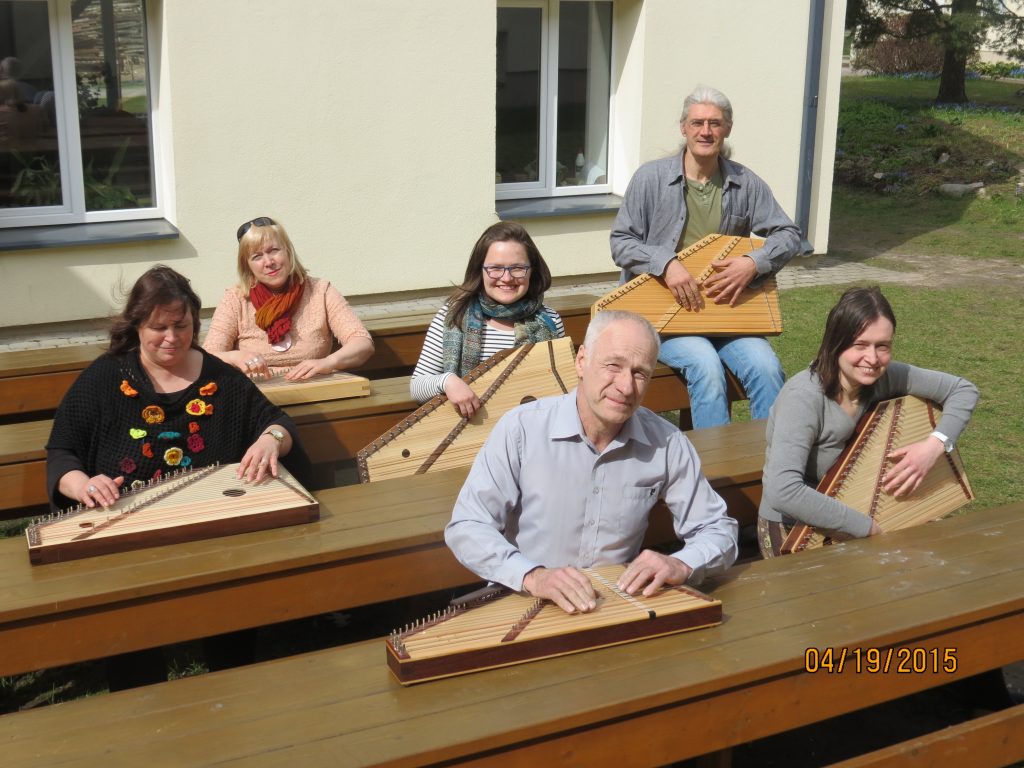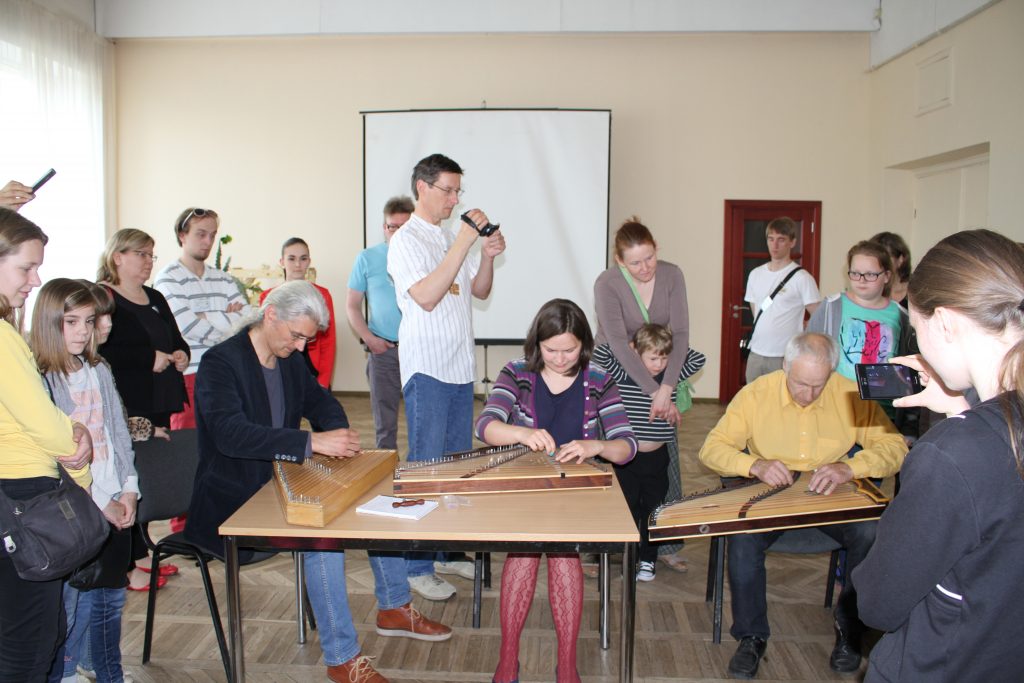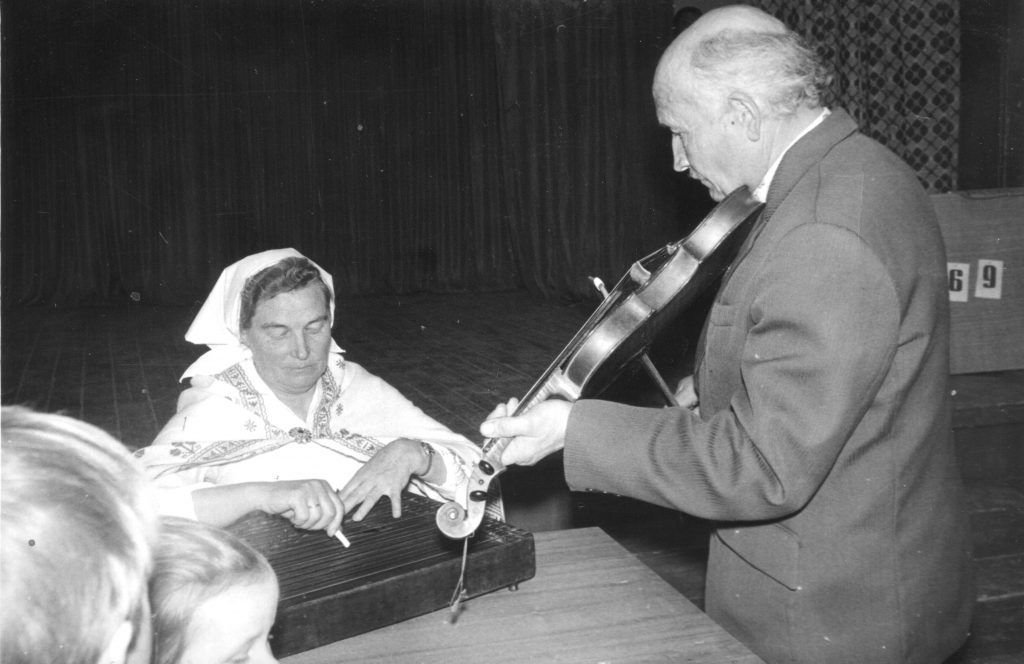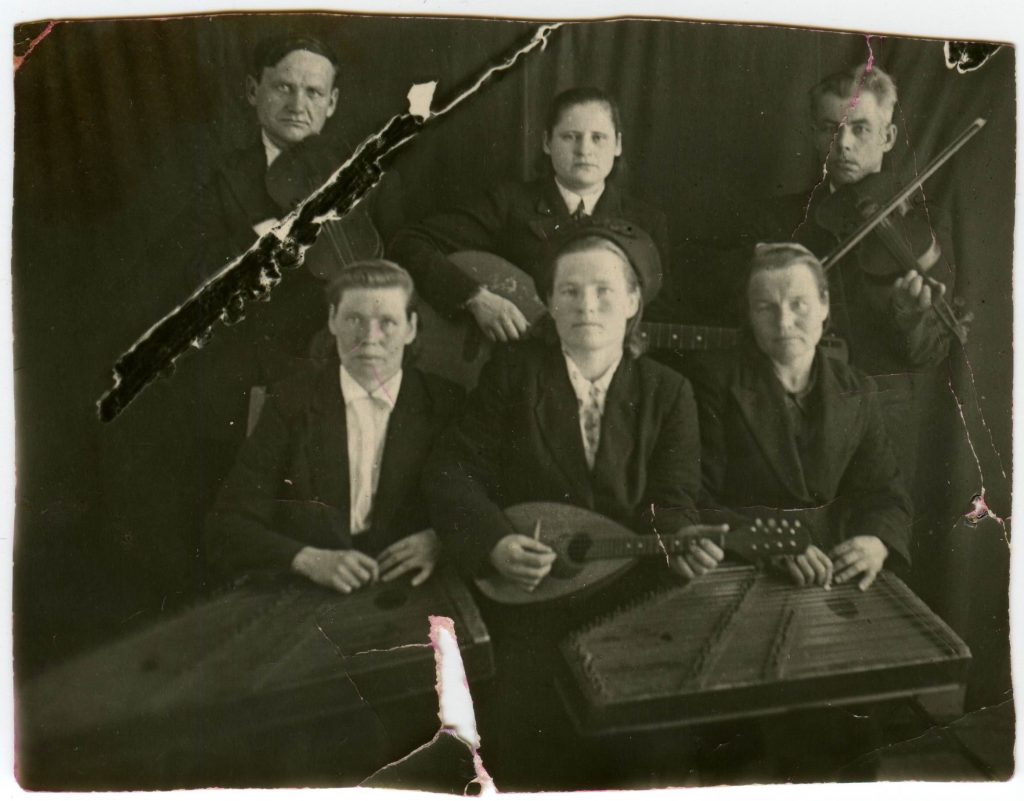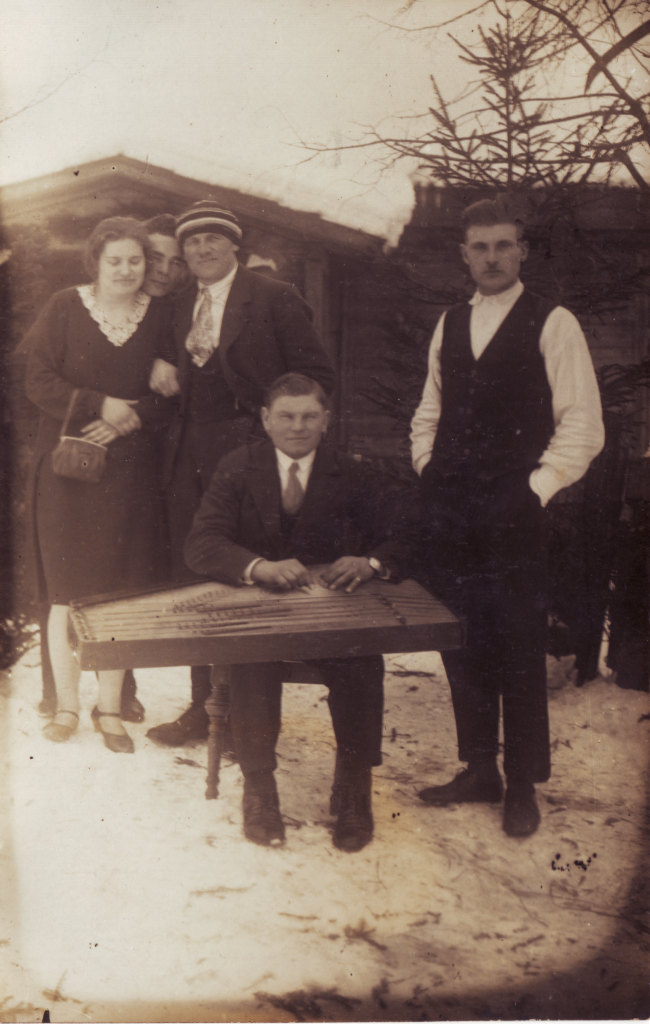Author:
Ilmārs Pumpurs
Music/performing arts
Title
Latvian Melodic Zither performance (2018)
The zither-kokle (in the scientific literature in the 80s of the 20th century, an artificial designation, which has now entered into daily communication, has also influenced the terminology used by the traditions in some cases). Zither, the “through-play” zither (Valters Reiznieks, Limbaži), the “through-play” kokle, the half-dur zither, the the half-dur kokle (Mārtiņš Baumanis, Augstroze); the kokle, koklīte, kūkleite (Jānis Uzkliņģis, Jānis Ločmelis, Janīna Kaimiņa, Balvi and Viļaka municipality), the big kokle (Ludza region), the cimbolīte (Konstantīns Mucenieks, Ziemeri), cītars, half-dur cītars (Francis Dukovskis, Balvi). “Izknaibīt” – play melody with thumb (Helēna Ločmele, Vilaka).
One of the terms used in the folk terminology has been selected for the description of the element – melodic zither performance or in Latvian: the through-play zither. The Latvian term concurrently names both the instrument and its characteristic type of play, allowing it to be clearly distinguished from other instruments of the instrument game (cimbole, kokle, zither playing), the names of which tend to overlap in the folk terminology.
Geography
The element was distributed mainly in Northern Vidzeme and Latgale. In the first half of the 20th century, individual players of the instrument have also worked elsewhere (Sēlija, Talsi, Tukums). The known tradition bearers now come from Northern Latgale, Balvi, Viļaka municipality, where information on the use, manufacture, playing techniques and repertoire of the instrument has also been obtained.
Currently, in areas where the inheritance element is still in active (known players) or passive (where the instrument is recognized, remembered but no longer used) use, it is recognised as a characteristic, valuable part of cultural heritage.
However, the few tradition bearers and teachers are no longer able to ensure the further transfer of the instrument performance and related skills to the extent necessary to preserve the tradition.
As a result of changes in the tradition inheritance mechanism from transferring the skill within a family or the local community to learning the skill in educational events (courses, lectures, video instructions), traditional culture or folk music enthusiasts get included in the tradition bearer community (or create new interest groups and communities) irrespective of the location.
Such groups are formed around persons who have acquired the instrument playing skills in courses, musical and ethnographic studies, or self-training, and continue to actively play music, ensuring the recognition and preservation of the playing skills.
Significance in community life
The function of the element is essentially not different from that of other traditional entertainment instruments typical of the 20th century.
The melodic zither is used in all situations where music is expected of permitted – formal and informal dance and other entertainment events, family and annual celebration events, playing for one's own joy or for other listeners.
The melodic zither is an instrument that makes it possible to make a melody with a bass line – chord accompaniment, played both on its own and in an ensemble with other, usually string instruments.
Activities
The performance of melodic zither is related to the knowledge of all the traditional musical situations that is formed by and requires the use of “mandatory” audience requested (songs, fashion dances etc.) repertoire and the artist's own favorite repertoire.
The zither was used only for the playing music at home, so much more often than other instruments it was played by women. When playing along with a band of musicians of melody instruments (usually violin, mandolin, garmon), the melodic zither player could play only the chord accompaniment that is much easier than playing the melody.
The design of the instrument requires good knowledge of woodworking technology, equipment and precision; it was usually carried out by special masters who did not always play themselves. However, the design of the instrument is not so complex as to create problems for the interested party to make or repair the instrument for their own needs. Also, not every player was capable of tuning of the instrument – a typical instrument has approximately 70 strings. There were some more skilled tuners who helped out other players in the area.
In Northern Latgale, the players of the instrument themselves usually call the instrument a kokle, giving the instrument part of the semantics typical of the ethnographic kokle – “our fathers' fathers' instrument” (J. Uzkraukis). Often, players also emphasized the importance of the exterior appearance of a beautiful instrument. The melodic zither performance is most often learned in the family circle, from parents, brothers, or other relatives.
Passing on and transferring skills
The melodic zither performance currently is no longer commonplace (if you do not take into account music playing at home, for your own enjoyment), but as a special rarity is shown in traditional cultural events, concerts, festivals.
All players of the instrument who have learned it recently are related to folklore or folk music groups, and use the instrument in their concert activities.
History
As household music playing and music culture developed, in the second half of the 19th century, more and more professionally made imported instruments appeared in the Latvian cultural space.
Part of these were included in existing traditions by supplementing or replacing the oldest musical instruments.
In these processes, in the last decades of the 19th century, as the imported neckless zithers merged with the older kokle making and playing traditions, a new peculiar instrument was formed – the Latvian melodic zither (in Estonian literature uuem kannel, rahvakannel).
By the beginning of the 20th century, the new instrument is found in Estonia, Northern Vidzeme and Northern and Central Latgale.
The shape of the instrument is similar in the entire range of distribution, but the string layout is different due to the different techniques of playing. The most common setup in the territory of Latvia has three chord groups or bass (T, D, S) string groups and about 18 double or triple melody strings tuned in octaves. The playing tradition is characterised by the creation of the accompanying chords in the lower part of the melody string set, with the fingers of the left hand covering non-chord strings (similar to the ethnographic kokle performance), with the right hand alternating between playing the free bass strings and chord strings in the melody string section. Simultaneously, the thumb of the left hand is used to play the melody. A similar playing technique is used in South-Eastern Estonia, in a small area along the Peipus Lake.
The instrument has been played both as a solo instrument and with garmon, violin and other characteristic folk music group instruments of the first half of the 20th century. The repertoire of the Latvian melodic zither is domestic music – dances and song melodies. The evidence of the use of the melodic zither is recorded since the turn of the 20th century, and it was actively built and played until the 1940s; starting with the 1950s a gradual disappearance of the tradition was observed.
The tradition, mainly passively, has remained until the modern day in the northern Latgale, the Balvi and Viļaka municipalities, where the instrument was still actively played until the 1970s–1980s.
The information about the playing technique and repertoire was also acquired there. However, despite the knowledge of the local community about the tradition and the appreciation of its value, the transfer of the playing skills in the former region of prevalence is no longer happening.
Currently, thanks to the activities of the “Skaņumāja” association, several interested people have learned how to make the instrument, as well as a number of players of the instrument have been trained, who are able to ensure the preservation of the skill.
Additional Information
The performance of the Latvian melodic zither is essentially not different from other traditional entertainment instruments typical of the 20th century. The melodic zither player must be familiar with situations (including ritual processes) where the music instrument game is acceptable, desirable or necessary, and the music repertoire applicable to each situation.
Being able to tune the instrument is important for the use of the instrument, and not all the players were able to perform this action.
Masters
Most of the few remaining Latvian melodic zither players (Janīna Kaimiņa in Medņeva, Helēna Ločmele in Viļaka etc.) are no longer able to play the instrument at a mastery level, but have provided essential information about the use of the instrument and the playing technique.
At a recognised level, the skill of the instrument performance has been preserved by Jānis Ločmelis from Medņeva, who learned the playing skill from his father during childhood, and built the instrument that he plays himself.
Through direct contact, as well as listening to recordings, several people have learned the melodic zither performance at a sufficient level to use it in practical music playing, demonstrating the instrument performance, and further teaching.
Ilmārs Pumpurs has learned the technique of playing the melodic zither by direct contact with the old masters; he teaches zither playing in “Skaņumāja” courses and uses the instrument while playing in the ensemble “Skaņumājas muzikanti”,
Valters Reiznieks learned the playing technique in “Skaņumāja” courses and has developed his skills to a considerable level; he actively uses the instrument in the concerts of the group “Ziemeļmala”,
Raitis Sondors has learned the playing technique in “Skaņumāja” courses; actively promotes the instrument by demonstrating it in various traditional culture events.
Agencies and institutions
1. The association “Skaņumāja”, prepared and promotes the ICH entry application, provides educational and promotion measures.
Basic information about the instrument and its playing technique can be found on the association website www.muzikanti.lv.
In the association workshop, technologies of building multiple models of the instrument have been developed; they have also built instruments for teaching the melodic zither performance and the needs of interested players.
Several instruments are at the disposal of the Jāzeps Vītols Latvian Academy of Music, where the opportunity to acquire the instrument performance skills is offered to students of ethnomusicology and kokle performance.
2. The association “IMUS”, provides the repair and manufacture of instruments as well as promotion activities.
Consolidation
Since 2005, the ethnomusicologist I. Pumpurs has been conducting research on the traditions of the Latvian melodic zither performance, a significant amount of previously collected material has been gathered. There has been a survey of most of the instruments available in different collections, historical photographs, sound and video recordings; as part of field studies, all players of the instrument currently identified in Latvia have been interviewed, resulting in a detailed description of the design, sound and playing technique of the instrument.
Over the last five years, complementary element retention activities have been targeted in several directions:
• Promotion of the tradition, including through practical use in concerts;
• The instrument is viewable and displayed in the “Skaņumāja” traditional instrument exposure. (Funding of the municipality of Ogre: EUR 1000, LNKC funding EUR 9859, funding of the NGO programme of the SCCF);
• Ilmārs Pumpurs and Raitis Sondors (LNKC total event funding – EUR 1000) perform at the 2018 concert of Baltica speakers and musicians;
• 2018. A self-study book on playing an instrument “Melodic Zither” (downloadable PDF) (EU education programme Erasmus, total project funding EUR 117875);
• 2018, 2019. “A bundle of ancient and rare musical instrument players” in Liepupe Parish with the participation of players of the piercing turtle. (Municipality of Salacgrīva, organisers – IMUS);
• 2019, 2020. Interchangeable tentacles and matches (with the participation of zither players) within the framework of the masterclass project “Let's play in Skaņumāja” (projects totalling EUR 4000 (2019) and EUR 4000 (2020 partially implemented due to pandemic restrictions);
• 2020 television stories on ReTv and LTV “Latvijas Sirdsdziesma”;
• 2020. A concert organised by the society “Lauska” was performed by the folk music group “Ziemeļmala” in the Ruķeļi, Amata municipality. (SCCF, organizer – the “Lauska” association. Total financing of the project EUR 3 600);
• 2020. Video concert cycle “Pērles kabatā”, film “Caurspēlējamā cītara” with several player and group performances in https://www.muzikanti.lv/caurspelejama-citara. (Total project financing of the VLM and SCCF Vidzeme Programme EUR 2000, total financing of the SCCF EUR 4290);
• July 4, 2020. Festival “4th anniversary of the Ziemeļmala,” in Limbaži. The melodic zither is played by the chapel “Ziemeļmala” (organizer – IMUS);
• Episodes with melodic zither playing are included in the film of national importance “Zeme, kas dzied” (2022);
• 2021. In the courses of the traditional musical instruments in Skrīveri was a 4-pupil band playing melodic zither. (Total financing of the ERCF project: EUR 5 500);
• A television programme “Skaņu ceļi. Caurspēlējamā cītara” has been created. (EUR 6585 from the SCCF);
• 2022. Information about melodic zither can be found in the national Encyclopedia, at the entry “Zither”;
• 2022. Festival Baltica. “Musical instruments Parade: the values of the intangible cultural Heritage” the melodic zither was played by “Skaņumāja” musicians Ilmārs Pumpurs, “Visi vēji” – Gundega Drava and Valters Reiznieks. (Total financing of the LNKC project EUR 1000);
• 2022 prepared programme for teaching the melodic zither playing in children's music schools (2-year-old module) (total funding 25000 for SCCF project);
• 2022. A lecture and masterclasses in meating of World Kokle players. Directed by Ilmārs Pumpurs. (Funding of the municipality of Valmiera). Estonian participants.
RESEARCH AND DOCUMENTATION
Tuning into the video concert cycle “Pērles kabatā. Caurspēlējamā cītara” played by Valters Reiznieks, Estere Eglīte and the band “Ziemeļmala.” The band “Ziemeļmala” has created quality records for about 10 pieces and posted on its Youtube account. 2023. Masters Valters Reiznieks and Ilmārs Pumpurs have been interviewed and a quality record of toolmaking has been prepared, placed in tradarhivs.jvlma.lv. Materials from this recording will be used at the 2023 Song and Dance Celebration musical instruments exhibition at Hansas perons. Zither player Jānis Ločmelis and members of the family of Medņeva musician Janīna Kaimiņa have been interviewed and filmed.
TRAINING TO PLAY
The training option is provided by the “Skaņumāja” traditional Instrument playing courses (2021–22) trained by 4 stakeholders), as well as the “Saspēlēsim Skaņumājā” masterclasses (2019, 2023). 2018. Published a self-study book of the Melodic Zither to be played in Latvian and English, downloadable in PDF format on the muzikanti.lv page. Valters Reiznieks teaches the basics of the skill for 4 interesting.
PROVISION/MANUFACTURE OF MUSICAL INSTRUMENTS
The repair and manufacture of the instruments is carried out by Ilmārs Pumpurs (society Skaņumāja) and Valters Reiznieks (society IMUS). In total, more than 10 instruments have been made up to 2023.
Awareness of the value of ICH and the understanding of the role of the instrument in Latvian musical traditions in society has increased. The availability of quality instruments (but also the market prices of historical instruments) has increased. The number of active players increases extremely slowly – 2–3 persons in the reporting period. Accordingly, the tradition is still considered to be severely endangered.
Previous activities have been implemented mainly thanks to the support of the CCF (music events, games courses, documentation, other promotional activities), the support of the EU programme Erasmus+ education (self-study book project), the funding of the national cultural Centre (education and music events, customary), the support of local governments (support for the conduct of music events), the contribution of private stakeholders (purchase of instruments, training costs).
All envisaged activities will continue as far as possible with any possible funding.
Continuation/development
Measures to promote the visibility of the element:
• All resources created to promote the element will be continuously maintained – Internet pages with informative, educational and artistic materials, information in the exhibition of sound instruments will be updated and expanded, ensuring the availability of information. Information on the traditions of the instrument game is constantly included in all information and educational events for the wider public and specialists – lectures, concert lectures, master classes, including those conducted within the framework of the Skolas soma. (Skaņumāja);
• Create an instrument for the play – the offer of an event dedicated to the values of NCH at the International Folklore Festival Baltica 2025. (Skaņumāja);
• The society “Skaņumāja” will continuously monitor the dynamics of the use of the instrument play, the identification and documentation of contemporary players, as well as the identification and collection of historical testimonies, photographs, instruments, etc.;
• Prepare a sound recording promoting the game of Curtina with the traditional musical group “sound musicians”. (Skaņumāja).
The following measures are planned for the protection and development of the element:
• Education. The society “Skaņumāja” shall organise at least one training group (3–5 trainees) of Melodic Zither to be played in the course of the traditional instrument play during the reporting period. Organise at least 1 masterclass each year to improve the skills of existing trained players. During the reporting period, to achieve the commencement of the playing programme of traditional instruments in vocational oriented cultural educational institutions; within the framework thereof the playing module of the melodic zither to be included. (Skaņumāja);
• Community activities. Starting from 2023, resumption of organising zither player tournaments in Limbaži region (possibly also in other places where the playing is started to practice), opportunities have been used to motivate players to attract relevant music groups and players to other music and traditional cultural events. (Skaņumāja, IMUS);
• Manufacture of tools. Work will continue on improving the sound quality of the instrument; different tunes for instruments, different designs. Produce at least 10 new instruments during the reporting period. (Skaņumāja, IMUS).
The objectives of the measures are NKM values – preservation, protection and popularisation of traditions of playing Melodic Zither. Ensure availability of sufficient quality information of all types, representation of tradition in presentation of music and cultural events, provision of inheritance through education, maintaining the number of experts necessary for stable maintenance and dissemination, as well as accessibility of instruments.
Threats
The traditions of the Latvian melodic zither performance remain a critically endangered element of the traditional culture.
As the cultural environment has been changing, the the performance of the instrument, along with other traditional musical forms, has lost its former functions, but because of the various circumstances it has also not been included in the range of the traditional folk music or folklore ensembles. The natural process of inheritance of the playing skills (active player – apprentice) is no longer in place. There is a lack of widely available information and awareness of the particular importance of this element in the cultural traditions of the region, which makes the public interest in accessing and maintaining it very low.
For an instrument with a relatively complex playing technique and at the same time relatively limited musical possibilities, without special support or awareness of added value, is practically impossible to withstand competition with other traditional and popular musical instruments.
Applicant
Association “Skaņumāja”, reg. no. 40008106801
Image Gallery
Audio Materials
Video
Publications
Priedīte Ī. (1983). Ko spēlēja sendienās. Rīga: Zinātne.
Priedīte Ī. (1993). Cītaras un meistari: katalogs. Rīga: Latvijas etnogrāfiskais brīvdabas muzejs.
Muktupāvels V. (2017). Tautas mūzikas instrumenti Latvijā. Rīga: Latvijas Universitātes Akadēmiskais apgāds
Websites
http://muzikanti.lv/lv/projekti/skanu-maja/speles-apmaciba/video/ - - a short video instruction of playing the melodic zither with some exercises and melody samples.

